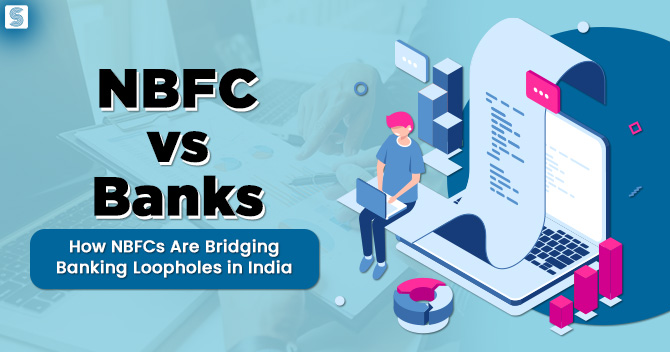NBFC vs Banks: How NBFCs Are Bridging Banking Loopholes in India

Shivani Jain | Updated: Jun 23, 2020 | Category: NBFC
Loans have become an essential part of availing immediate financial assistance, be it for personal use or business purposes. Loans may be used to boost business, handle some personal emergency, purchase some property or uplift the borrower’s living standards. Earlier, traditional banks were known to dominate and lead the Indian financial sector. However, in the recent years, the situation has changed, with the advent of NBFCs (Non-Banking Financial Companies) in India. In this learning blog, we will discuss in-depth the concept of NBFC vs Banks and how NBFCs are bridging the gaps left by banks in serving the credit needs of the public.
Table of Contents
NBFC vs Banks: Concept
Meaning of Non-Banking Financial Company
Throughout the economic crisis of 2009 in India, businesses struggled with their financial due to the liquidity crash faced by the banking sector in India. The banks which were the creditors of the defaulting companies[1] struggled to stay afloat. Relying on banking institutions started to look like an unapproachable option for businesses and individuals. Thus, alternative means of finance, i.e. the Non-Banking Financial Companies provided a way out by bridging the gaps left by banks in terms of safety and accessibility.
NBFCs (Non-Banking Financial Companies) in India play a crucial role in the country’s economy by offering financial assistance not only to businesses but also to the weaker sections of the society that did not have access to banking facilities. An NBFC is a company registered under the provisions of Companies Act, 2013 and regulated by the RBI (Reserve Bank of India).
Although NBFCs are distinct from banks, they are involved in identical lending activities to businesses and individuals as per the conditions and guidelines issued by the Apex Bank [2] . Simply, there are some aspects on which the functioning of NBFC vs Banks are similar to each other as both provide loans and advances, credit assistance, savings to the general public.
Meaning of Banks
Banks are the apex institutions that are responsible for the smooth working of the economy within the country. They are engaged in activities like accepting deposits, maintaining credit flow, managing withdrawals, providing secure money transfers, granting loans, clearing cheques, and other financial services to customers. Moreover, to contribute to initiatives like cashless and digital India, banks have recently started services like mobile banking, net banking, etc.
Additionally, banks help in boosting the country’s economic growth and act as financial intermediaries between the borrowers and depositors. The Indian banking sector includes private, public and foreign banks functioning in the country. Lastly, the ownership of bank vests with its shareholders.
NBFC vs Banks: Activities
NBFC
In India, the activities of NBFCs prescribed by RBI can be summarised as:
- NBFCs cannot accept Demand Deposits like Banks;
- NBFCs are not allowed to be a part of any payment or settlement mechanism;
- NBFCs are not allowed to issue or draw cheques on themselves;
- NBFCs are not allowed to provide Insurance to the Deposits; and
- NBFCs are not allowed to provide credit guarantee to its customers.
Banks
In India, the activities of Banks can be summarised as:
- Banks lend money to their customers by making advances;
- Bank accepts deposits from the public against a small amount of interest;
- Banks discounts bills of exchange;
NBFC vs Banks: Eligibility for Loans and Advances
Banks
Banks offer financial assistance only for a certain portion of the credit requirement. However, a bank employs stringent procedures and demographic conditions to accept an individual or a business as its customer. As a result, a significant part of the society remains deprived of banking services and facilities.
NBFCs
In comparison to banks, NBFCs offer loans and advances for almost the full credit requirements of their customers. The eligibility criteria of NBFCs is more relaxed and straightforward. This allows people from rural sectors to get loans even though they have limited disposable income or no credit history.
NBFC vs Banks: Rate of Interest
Banks
Banks are not allowed to grant credit below the MCLR (Marginal Cost of Funds based Lending Rate). The loans offered by the banks are associated with the concepts of Macro-Economics, including global market situations, lending rates prescribed by the Apex Bank.
NBFCs
The interest rate charged by NBFCs is based on PLR (Prime Lending Rate). Instead of regulating the interest rates charged by an NBFC on its products, the RBI prescribes a limit within which such NBFC can charge a rate of interest from their borrowers. Due to this mechanism, NBFCs have the freedom to either reduce or increase the interest rates on their different loan products to invite a larger customer base. Moreover, borrowers also benefit from this as NBFCs offer flexible loan tenures as well as interest rates to their customers.
NBFC vs Banks: Dealing in Negotiable Instruments
Banks
The term “Negotiable instruments” include cheques, bills of exchange, demand drafts, cheques, promissory notes. In India, banks have the authority to issue and accept negotiable instruments. They even allow their account holders to withdraw funds by using negotiable instruments.
NBFCs
However, an NBFC is not allowed to issue, accept, or deal in negotiable instruments.
NBFC vs Banks: Documentation for Processing Loan
Banks
For availing loans, the customers have to undergo strict requirements, lengthy paperwork, and document verification. Moreover, some banks still rely on manual document verification, and this, as a result, increases the time involved in processing a loan.
NBFCs
In contrast, NBFCs include not only simple KYC (Know Your Customer) and AML (Anti Money Laundering) documentation requirements, but they have allowed their customers to submit the required documents online. A loan from these non-banking institutions involves lesser paperwork and shorter processing time.
NBFC vs Banks: Customised Loans Products
Banks
In the case of Banks, customers are offered only fixed loan products, i.e. banks do not provide customised loan products.
NBFCs
In contrast, NBFCs offer personalised loan products to match the financial requirements of their customer. The term “personalised loan products” includes the choice of the repayment period, flexible interest rates, modes of repayment, and many other offers and discounts.
NBFC vs Banks: Good Credit Score
Banks
Good credit score acts as a parameter for the Indian Banks to decide whether a loan applicant is worthy of receiving financial assistance or not. Due to this, a significant count of individuals and business entities gets excluded from obtaining loans.
NBFCs
On the other hand, NBFC offers loans and credit facilities to everyone, be it individuals or business entities, even when the loan applicant does not possess a credit history. However, an NBFC must make sure that it has a robust risk management policy and default management strategy to reduce the chances of NPA (Non-Performing Assets).
NBFC vs Banks: Acceptance of Deposits
Banks
In India, banks accept all types of deposits, including demand deposits, from their customers. The word “deposit” includes recurring deposits (RD), fixed deposits (FD), and time-bound deposits.
NBFCs
In India, an NBFC can only accept public deposits for a minimum tenure of one year and a maximum tenure of five years. Further, an NBFC is not allowed to accept deposits that are repayable on demand. Furthermore, an NBFC is also not allowed to offer interest rates more than the ceiling rate prescribed by the Reserve Bank of India. It shall be noteworthy to state that an NBFC is allowed to accept demand deposits from its customers only after obtaining special permission from the Apex bank.
NBFC vs Banks: Protection on Deposits
Banks
Banks provide protection on deposits by insurance up to a prescribed limit. Further, the Deposit Insurance Credit Guarantee Corporation provides insurance protection on bank deposits.
NBFCs
However, the deposits accepted by NBFC- NDs (Deposit Taking Non-Banking Financial Companies) do not have such insurance protection.
NBFC vs Banks: Customers Grievance Redressal
Although the primary function of both banks and NBFCs is to meet loan requirement, the entire financial sector is prominently into providing customer services. However, when it comes to devoted customer service or customer grievance redressal, most of the time, NBFCs outperform banks.
With every loan approval, the customer is allowed to keep a check of all the loan details, payments, charges, and statuses on its online platform. Moreover, customers are also assigned an RM (Relationship Manager) who attends to all their queries and efficiently manages their loan.
NBFC vs Banks: Overdraft Facility
The overdraft facility helps to minimise interest through pre-payments. Moreover, a loan with the overdraft facility is linked to the customer’s account and surplus funds can be deposited in that bank account. These surplus payments over and above the EMI are considered as pre-payments towards the actual loan. This brings down the total loan liability and saves on interest payments.
For example, a loan has been availed of Rs 50 lakhs for 20 years, at an annual interest rate of 8.6%. The total amount of interest paid comes to approximately Rs 55 lakhs over the entire home loan period, which is far more than the principal amount.
Further, Banks are entitled to offer the facility of overdraft to their borrowers, but the same is not the case with NBFCs.
NBFC vs Banks: Flexibility
NBFCs, with their proactive, dynamic and aggressive marketing policies, offer more flexibility while granting loans. For example, Flexi interest-only loans and Flexi term loans.
In Flexi term loans, both the principal amount and the interest form the EMIs, whereas, in Flexi interest-only loans, only the interest component constitutes the EMIs. There is an option of paying back the principal at the end of the loan period. This, in result, brings down the EMI amount.
NBFC vs Banks: Late Payments
All kinds of loans have some associated charges attached. Both NBFCs and banks tend to charge for pre-payment and foreclosure. However, the charges levied by NBFCs are higher than in comparison to banks. Moreover, their late payment charges can be up to 15-20% of the monthly EMI.
Further, the processing fees are also higher by NBFC vs banks, even though some banks may charge correspondingly. Therefore, a borrower must make sure to calculate future interests and additional costs with a repayment before choosing a lender.
NBFC vs Banks: Regulation
Banks
Banks are registered under the provisions of the Banking Regulation Act, 1949. Further, they are strictly monitored by the Apex Bank as they deal with the public deposits.
NBFCs
An NBFC or Non-Banking Financial Company is incorporated under the provisions of the Companies Act, 2013. However, it also needs to obtain registration with the RBI. Further, they are strictly monitored by the Apex Bank, but the extent of control is less than the banks.
NBFC vs Banks: Star Rating
Star Rating is another prime factor between NBFC vs banks. For instance, the deposits of NBFCs need to have a star rating, whereas bank deposits do not require any such evaluation. The reason for it is that the bank deposits are considered very secure and safe, while the same is not the case with NBFC deposits.
Therefore, it is always suggested to check the star ratings of an NBFC before investing in it. The ones with AAA-rating are considered as good quality deposits, implying the safety and timely payment of principal amount and interest.
NBFC vs Banks: Target Market
Banks
Banks always attract corporates as well as retailers from their policies.
NBFCs
In contrast, NBFCs are more equipped to handle the unorganised sector of businesses as well as the retail industry.
For instance, remote areas such as rural or semi-urban sections of the country may not have branches of any bank. However, there may be some person or more, acting as agents of NBFCs.
NBFC vs Banks: Issuance of Credit Card
Banks
Another difference is in the term of credit card issuance. Banks have the authority to regularly issue credit cards of varied types depending on the customers. They can also issue ATM cards.
NBFCs
NBFCs are not authorised to issue credit cards, debit cardsor ATM cards.
NBFC vs Banks: Foreign Investment
NBFCs
An NBFC after taking permission from RBI is allowed to take up foreign investments to 100%.
Banks
However, only the private sector banks are allowed to take up foreign investment in the case of banks, but only to a specific limit.
NBFC vs Banks: Reserve Ratio
Banks
For banks, it is mandatory to maintain minimum reserve ratios such as SLR (Statutory Liquidity Ratio) and CRR (Cash Reserve Ratio).
NBFCs
Conversely, NBFCs do not require to maintain any such minimum reserve ratios.
NBFC vs Banks: Forex Transactions
Banks
Commercial Banks are allowed to undertake activities related to foreign exchange as authorised dealers.
NBFCs
On the other hand, NBFCs are not allowed to undertake foreign exchange transactions without obtaining FFMC License (Full-Fledged Money Changer) from the RBI.
NBFC vs Banks: Credit Rating
Banks
Banks do not require to have a credit rating for accepting deposits.
NBFCs
However, it is a compulsory requirement for NBFCs to have credit ratings before accepting public deposits.
Summarised Difference between NBFC vs Banks
| Area | Banks | NBFCs |
| Meaning | Banks are government organisations engaged in activities like accepting deposits, maintaining credit flow, managing withdrawals, secure money transfers, granting loans, clearing cheques, and other financial services to customers | NBFCs are involved in providing financial services to businesses and individuals as per the conditions and guidelines issued by the Apex Bank. |
| Demand Deposits | Banks can accept all kinds of deposits. | NBFCs cannot accept demand deposits. |
| Deposit Insurance | Covered under the RBI’s deposit insurance. | No Deposit Insurance |
| Payment and Settlement Mechanism of the RBI | Banks are backed by the RBI’s Payment and Settlement mechanism like RTGS, NEFT. | NBFCs can not avail of the RBI’s payment and settlement mechanism. |
| Foreign Direct investment | Allowed up to a specific limit. | Allowed up to 100%. |
| Cash Reserve Ratio | Applicable in the case of banks. | Not applicable in the case of NBFCs. |
| CRAR | Applicable in the case of Banks. | Applicable up to 15% CRAR for the Deposit seeking NBFCs (NBFCs- D) and Non-Deposit seeking – Systemically Important NBFCs (NBFCs -SI- ND). |
| Statutory Liquidity Ratio | Applicable in the case of banks | Only the deposit-taking NBFCs requires to maintain 15% SLR. |
| SARFAESI Act | Applicable in the case of banks. | Applicable in the case of NBFCs as well. |
| Governing Law | Banks are registered under the provisions of the Banking Regulation Act, 1949. | NBFCs are registered under the provisions of Companies Act, 2013, and acquire a license to operate as a Non-Banking Financial Company under RBI Act, 1934. |
| Credit Ratings | Not Required in case of Banks. | Required in case of NBFCs. |
| Forex Transactions | Banks are allowed to undertake activities related to foreign exchange | NBFCs can undertake activities related to foreign exchange only after obtaining an FFMC license from RBI. |
| Credit Cards | Banks are allowed to issue credit cards | NBFCs are not authorised to issue credit cards. |
| Good Credit Score | Banks require a good credit score or credit history before granting loans. | NBFCs do not require a good credit score. |
Conclusion
In view of the aforementioned differences, it is evident that NBFCs play a crucial role in boosting the economy of a country. By satisfying the credit requirements of the MSME sector, the non-banking financial companies tend to spur the growth of economically weaker sections that lack necessary financial solutions.
Moreover, NBFCs outperform conventional banks in terms of ease of offering business loans. The financial stability report issued by the apex bank has also revealed that the functioning of NBFCs has improved remarkably.
NBFCs are definitely bridging the gaps between the banked and unbanked markets with their technologies, processes and hybrid operations. Therefore, with regard to benefits and future trends in the non-banking financial sector, it is suggested to opt for NBFCs for quick and hassle-free financial solutions.
Also, Read:NBFC vs Banks: The Best Option for Getting Loans in India















